Themed collection Multimolecular Crowding in Biosystems

Fluorescent probes for targeting endoplasmic reticulum: design strategies and their applications
Fluorescent molecules for monitoring endoplasmic reticulum and chemical probes for the detection of ER cellular processes and analytes.
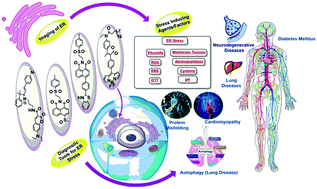
Chem. Commun., 2022,58, 2413-2429
https://doi.org/10.1039/D1CC06944F
Reaction-based fluorescent and chemiluminescent probes for formaldehyde detection and imaging
The major developments of fluorescent and chemiluminescent formaldehyde probes have been summarized in this highlight.
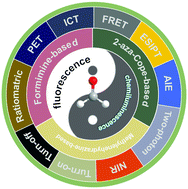
Chem. Commun., 2022,58, 1442-1453
https://doi.org/10.1039/D1CC05644A
Small-molecule fluorescent probes: big future for specific bacterial labeling and infection detection
In the last decade, small-molecule fluorescent probes brightened the bacteria and infections.
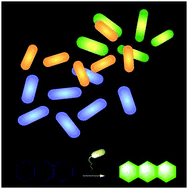
Chem. Commun., 2022,58, 155-170
https://doi.org/10.1039/D1CC05531C
Cancer diagnosis and analysis devices based on multimolecular crowding
The study of multimolecular crowding has opened up the possibility of developing new devices for cancer diagnosis and analysis.
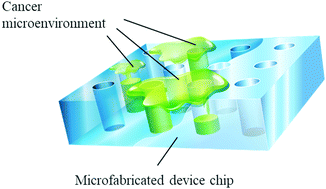
Chem. Commun., 2021,57, 13655-13661
https://doi.org/10.1039/D1CC05556A
Regulation of liquid–liquid phase separation with focus on post-translational modifications
This feature article introduces some regulators of biomolecular condensates formed through liquid–liquid phase separation (LLPS), especially post-translational modifications (PTMs).
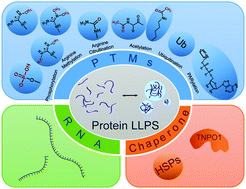
Chem. Commun., 2021,57, 13275-13287
https://doi.org/10.1039/D1CC05266G
Enzymatic noncovalent synthesis of peptide assemblies generates multimolecular crowding in cells for biomedical applications
This article highlights the unique features of enzymatic noncovalent synthesis (ENS) for generating multimolecular crowding in cells and the relevant applications for biomedicines.
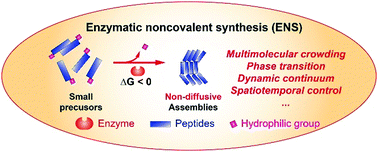
Chem. Commun., 2021,57, 12870-12879
https://doi.org/10.1039/D1CC05565H
Chemogenetics of cell surface receptors: beyond genetic and pharmacological approaches
In this review, we describe chemogenetics of cell surface receptors. This approach using designer ligands allows for rapid and selective control of the designer receptor function without affecting the endogenous systems.
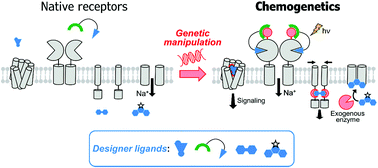
RSC Chem. Biol., 2022,3, 269-287
https://doi.org/10.1039/D1CB00195G
Molecular probes for cellular imaging of post-translational proteoforms
Specific post-translational modification (PTM) states of a protein affect its property and function; understanding their dynamics in cells would provide deep insight into diverse signaling pathways and biological processes.
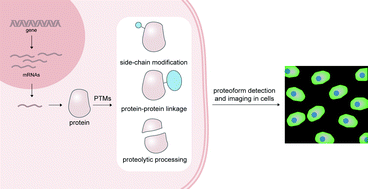
RSC Chem. Biol., 2022,3, 201-219
https://doi.org/10.1039/D1CB00190F
A fluorogenic probe targeting two spatially separated enzymes for selective imaging of cancer cells
We describe a fluorogenic probe BocLys(Ac)-AB-FC targeting both histone deacetylases (HDACs) and cathepsin L, which are overexpressed in spatially separated subcellular organelles of cancer cells.

Chem. Commun., 2022,58, 4079-4082
https://doi.org/10.1039/D2CC01082H
A coumarin-based reversible two-photon fluorescence probe for imaging glutathione near N-methyl-D-aspartate (NMDA) receptors
In this article, we report coumarin derivative 1 bearing cyanoacrylamide and ifenprodil moieties as the first reversible fluorescent probe that can monitor GSH near NMDA receptors.
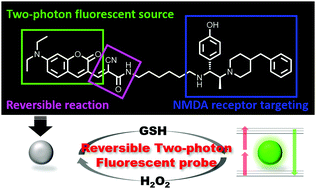
Chem. Commun., 2022,58, 3633-3636
https://doi.org/10.1039/D1CC05512G
Intracellular photocatalytic-proximity labeling for profiling protein–protein interactions in microenvironments
Intracellular photocatalytic-proximity labeling (iPPL) was developed to profile protein–protein interactions in the microenvironment of living cells.
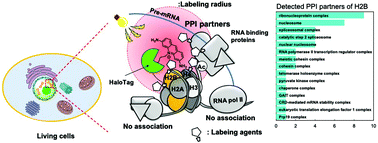
Chem. Commun., 2022,58, 1926-1929
https://doi.org/10.1039/D1CC05764B
Development of 1,8-naphthalimide dyes for rapid imaging of subcellular compartments in plants
We report the installation of 1,8-naphthalimide dyes in live cell imaging of plants. The structure of the chloroplasts or vacuole was rapidly and clearly visualized by 1,8-naphthalimide dyes.
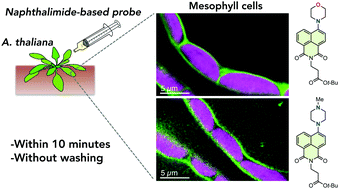
Chem. Commun., 2022,58, 1685-1688
https://doi.org/10.1039/D1CC05798G
Tumour enzyme affinity mediated peptide molecular crowding for targeted disruption of hyperactivated glucose uptake
An unconventional environment-responsive molecular crowding via specific binding between small molecule peptide inhibitor derivatives and overexpressed tumour enzyme has been developed.

Chem. Commun., 2022,58, 1350-1353
https://doi.org/10.1039/D1CC06049J
Bottom-up/cross-linking mass spectrometry via simplified sample processing on anion-exchange solid-phase extraction spin column
Capturing proteins on anion-exchange discs facilitates concentration of diluted samples and removal of contaminants, allowing more efficient sample pretreatment for bottom-up/cross-linking mass spectrometry than in-solution and in-gel.
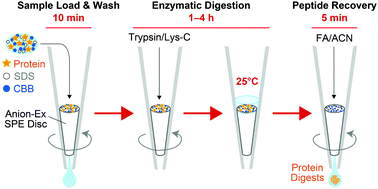
Chem. Commun., 2022,58, 775-778
https://doi.org/10.1039/D1CC05529A
ROS activated prodrug for ALDH overexpressed cancer stem cells
We developed a prodrug (DE-CPT) that efficiently decreases the cancer stem cell population and kills the cancer cells by ROS activation.
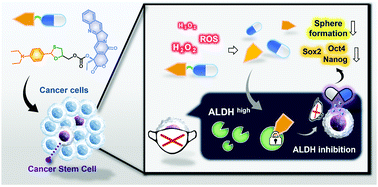
Chem. Commun., 2022,58, 72-75
https://doi.org/10.1039/D1CC05573A
Intramolecular G-quadruplex-hairpin loop structure competition of a GC-rich exon region in the TMPRSS2 gene
We identified cytosine-rich regions adjacent to guanine-rich regions in the TMPRSS2 gene, which showed structural competition between a G-quadruplex and a hairpin loop. Furthermore, this competition significantly affected transcription efficiency.
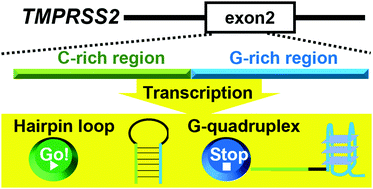
Chem. Commun., 2022,58, 48-51
https://doi.org/10.1039/D1CC05523B
Pyridinium-conjugated polynorbornenes for nanomolar ATP sensing using an indicator displacement assay and a PET strategy
Novel polynorbornene-based probes for fluorescence sensing of ATP at nanomolar levels via the indicator displacement assay (IDA) method are reported.
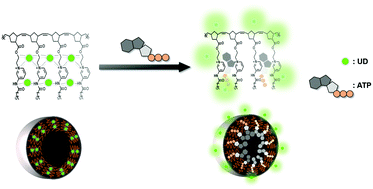
Chem. Commun., 2021,57, 13530-13533
https://doi.org/10.1039/D1CC05500C
Harnessing stress granule formation by small molecules to inhibit the cellular replication of SARS-CoV-2
Small-molecule enhancers of cellular stress granules were identified by observing molecular crowding of proteins and RNAs in a time-dependent manner. Hit molecules inhibited the replication of SARS-CoV-2 by inducing stress granule formation.
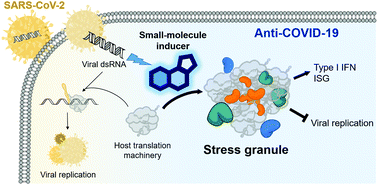
Chem. Commun., 2021,57, 12476-12479
https://doi.org/10.1039/D1CC05508A
Calix[n]triazolium based turn-on fluorescent sensing ensemble for selective adenosine monophosphate (AMP) detection
We report a series of calix[n]triazoliums showing excellent selectivity for AMP. The unique supramolecular ensemble exhibits a selective turn-on fluorescence response towards AMP over various anions, including adenosine polyphosphates.
![Graphical abstract: Calix[n]triazolium based turn-on fluorescent sensing ensemble for selective adenosine monophosphate (AMP) detection](/en/Image/Get?imageInfo.ImageType=GA&imageInfo.ImageIdentifier.ManuscriptID=D1CC04950J&imageInfo.ImageIdentifier.Year=2021)
Chem. Commun., 2021,57, 12139-12142
https://doi.org/10.1039/D1CC04950J
Metabolic iron detection through divalent metal transporter 1 and ferroportin mediated cocktail fluorogenic probes
A cocktail [1 + 2] dual-fluorescent probe system could realize the real-time visualization of dynamic iron state changes between Fe2+ and Fe3+.
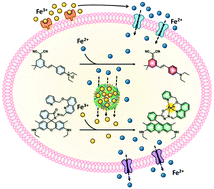
Chem. Commun., 2021,57, 7902-7905
https://doi.org/10.1039/D1CC03150C
Distinct impact of glycation towards the aggregation and toxicity of murine and human amyloid-β
Modifications of mAβ and hAβ by glycation can differentiate their aggregation and cytotoxicity profiles.
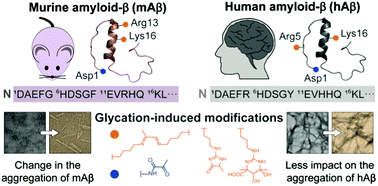
Chem. Commun., 2021,57, 7637-7640
https://doi.org/10.1039/D1CC02695J
Nongenetic control of receptor signaling dynamics using a DNA-based optochemical tool
We demonstrated the nongenetic temporal control of cell signaling using a DNA-based synthetic surrogate of growth factor.

Chem. Commun., 2021,57, 5969-5972
https://doi.org/10.1039/D1CC01968F
Molecular design of near-infrared (NIR) fluorescent probes targeting exopeptidase and application for detection of dipeptidyl peptidase 4 (DPP-4) activity
We developed a new molecular design for NIR fluorescent probes that target exopeptidase by utilizing the >110 nm blueshift of unsymmetrical Si–rhodamines.

RSC Chem. Biol., 2022,3, 859-867
https://doi.org/10.1039/D1CB00253H
Embedding a membrane protein into an enveloped artificial viral replica
We demonstrate the embedding membrane protein, Cx43, on the enveloped artificial viral capsid using a cell-free expression system. The embedding of Cx43 on the envelope was evaluated by detection with anti-Cx43 antibody using FCS and TEM.
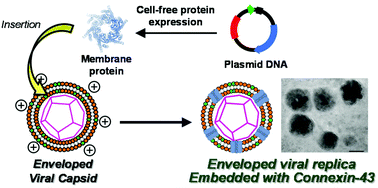
RSC Chem. Biol., 2022,3, 231-241
https://doi.org/10.1039/D1CB00166C
Versatile naphthalimide tetrazines for fluorogenic bioorthogonal labelling
New naphthalimide tetrazine probes permit fluorescent imaging of biomolecules in vitro and in living cells. They can be modified to provide previously unknown information about health and disease in biological systems.
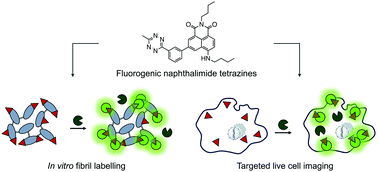
RSC Chem. Biol., 2021,2, 1491-1498
https://doi.org/10.1039/D1CB00128K
Lysine succinylation on non-histone chromosomal protein HMG-17 (HMGN2) regulates nucleosomal DNA accessibility by disrupting the HMGN2–nucleosome association
Succinylated HMGN2, prepared by a ‘thiol–ene reaction’, disrupted the association of HMGN2 with the nucleosome and increased nucleosomal DNA accessibility.
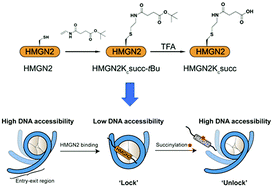
RSC Chem. Biol., 2021,2, 1257-1262
https://doi.org/10.1039/D1CB00070E
About this collection
Living cells comprise a variety of molecules from small cations/anions, metabolites, lipids, peptides, to biopolymers such as peptides/proteins, polysaccharides, and nucleic acids. These biomolecules are highly condensed inside the live cells and their distribution and concentration are heterogeneously varied (in a controlled manner). Such multimolecular crowding conditions are sharply distinct from those of conventional biochemical study, should be crucial for elucidating structures and functions of biomolecules in live cells, as well as for developing functional artificial molecules useful in chemical biology study, drug discovery, and medical diagnosis.
In this cross-journal themed issue, explore research papers, reviews, and communications in ChemComm and RSC Chemical Biology concerning chemical, physical, theoretical, or biological characterization of various biomolecules under the multimolecular crowding conditions. Also discover the development of chemical tools and devices enabling the detection and imaging of key biomolecules and the relevant events in live cells, methods for the structural modification and functional switching/control of biomolecules, and analytical or physical chemistry approaches applicable to study of multimolecular crowding biosystems.